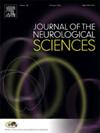Hippocampal sclerosis in senile dementia of the neurofibrillary tangle type
IF 3.6
3区 医学
Q1 CLINICAL NEUROLOGY
引用次数: 0
Abstract
Introduction
Senile dementia of the neurofibrillary tangle type (SD-NFT) is a subset of dementia in elderly individuals. Recent studies have reported a correlation between hippocampal sclerosis (HS) and aging. This study aimed to investigate the relationship between HS and SD-NFT.
Methods
We conducted a clinical and neuropathological review of Japanese patients diagnosed with SD-NFT. Hematoxylin–eosin and Klüver–Barrera staining, Gallyas silver impregnation, and immunohistochemistry were employed. Pathological assessments focused on identifying HS, neuritic plaques, and phosphorylated transactive response DNA-binding protein 43 (p-TDP-43)-positive inclusions. Additionally, we quantified the densities of neurofibrillary tangles (NFTs) and ghost tangles (GTs) within the hippocampal CA1 region.
Results
Nine patients met the criteria for SD-NFT from the patients who underwent consecutive autopsies from 1994 to 2022 at our institute. The mean ages at onset and death were 84.0 ± 6.8 years (range, 76–94 years) and 91.0 ± 7.0 years (range, 79–101 years), respectively. The mean dementia duration was 7.0 ± 4.0 years (range, 1–13 years). All patients exhibited memory loss although none were diagnosed with SD-NFT during their lifetime. The mean brain weight was 1124.2 ± 132.1 g (range, 980–1390 g). Three patients displayed HS. NFT and GT densities were significantly higher in patients with HS than in those without HS. No significant correlation was found between HS and p-TDP-43 inclusions in the medial temporal lobe.
Conclusion
In SD-NFT, NFTs are more strongly associated with HS. This finding enhances our understanding of the pathological underpinnings of HS in SD-NFT.
神经原纤维缠结型老年性痴呆的海马硬化
神经原纤维缠结型老年痴呆(SD-NFT)是老年人痴呆症的一个子集。最近的研究报道了海马硬化(HS)与衰老之间的相关性。本研究旨在探讨HS与SD-NFT的关系。方法对诊断为SD-NFT的日本患者进行临床和神经病理学回顾。采用苏木精-伊红染色、kl ver - barrera染色、galyas银浸渍和免疫组织化学染色。病理评估的重点是识别HS、神经斑块和磷酸化的交互反应dna结合蛋白43 (p-TDP-43)阳性包涵体。此外,我们量化了海马CA1区域内神经原纤维缠结(nft)和鬼缠结(GTs)的密度。结果我院1994 ~ 2022年连续尸检的患者中,有9例符合SD-NFT标准。平均发病年龄为84.0±6.8岁(范围76 ~ 94岁),平均死亡年龄为91.0±7.0岁(范围79 ~ 101岁)。痴呆的平均持续时间为7.0±4.0年(范围1-13年)。所有患者都表现出记忆丧失,尽管没有人在其一生中被诊断为SD-NFT。平均脑重1124.2±132.1 g(范围980 ~ 1390 g), 3例表现为HS。HS患者的NFT和GT密度明显高于无HS患者。HS与内侧颞叶p-TDP-43包裹体无显著相关性。结论SD-NFT中,nft与HS的相关性更强。这一发现增强了我们对SD-NFT中HS病理基础的理解。
本文章由计算机程序翻译,如有差异,请以英文原文为准。
求助全文
约1分钟内获得全文
求助全文
来源期刊

Journal of the Neurological Sciences
医学-临床神经学
CiteScore
7.60
自引率
2.30%
发文量
313
审稿时长
22 days
期刊介绍:
The Journal of the Neurological Sciences provides a medium for the prompt publication of original articles in neurology and neuroscience from around the world. JNS places special emphasis on articles that: 1) provide guidance to clinicians around the world (Best Practices, Global Neurology); 2) report cutting-edge science related to neurology (Basic and Translational Sciences); 3) educate readers about relevant and practical clinical outcomes in neurology (Outcomes Research); and 4) summarize or editorialize the current state of the literature (Reviews, Commentaries, and Editorials).
JNS accepts most types of manuscripts for consideration including original research papers, short communications, reviews, book reviews, letters to the Editor, opinions and editorials. Topics considered will be from neurology-related fields that are of interest to practicing physicians around the world. Examples include neuromuscular diseases, demyelination, atrophies, dementia, neoplasms, infections, epilepsies, disturbances of consciousness, stroke and cerebral circulation, growth and development, plasticity and intermediary metabolism.
 求助内容:
求助内容: 应助结果提醒方式:
应助结果提醒方式:


